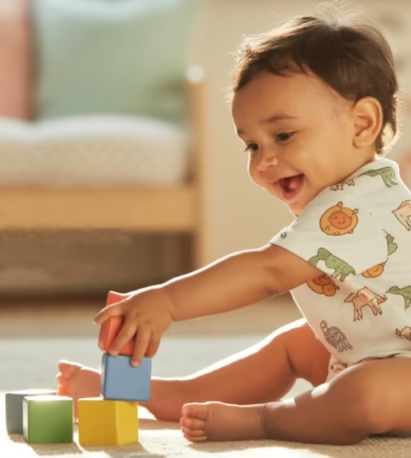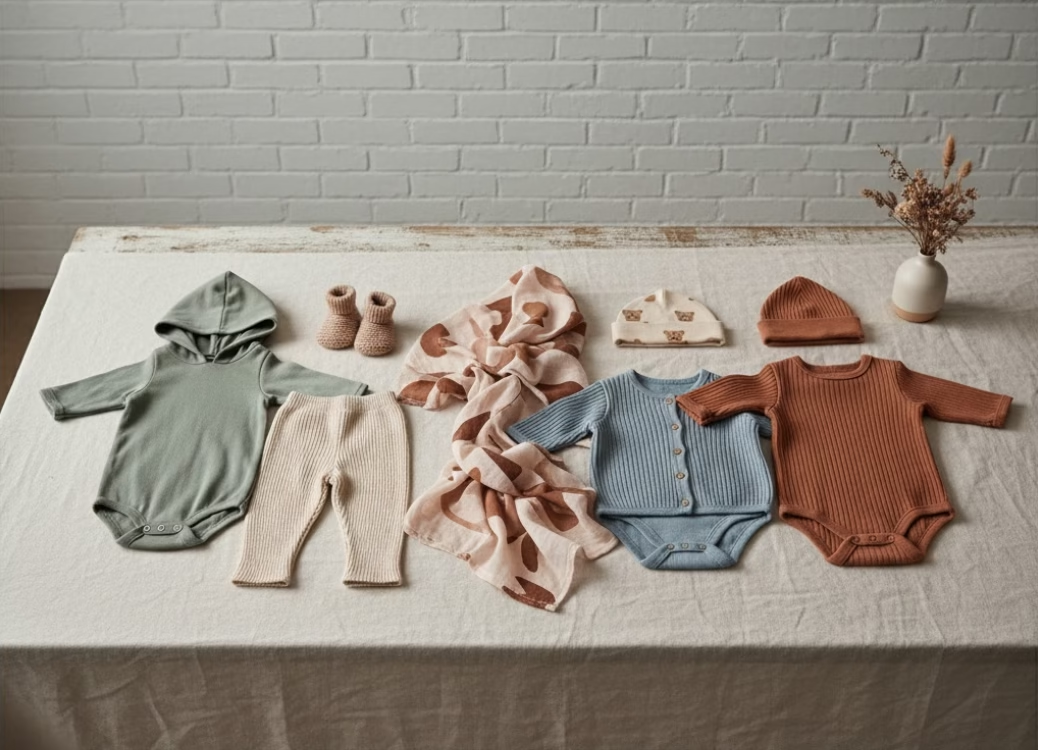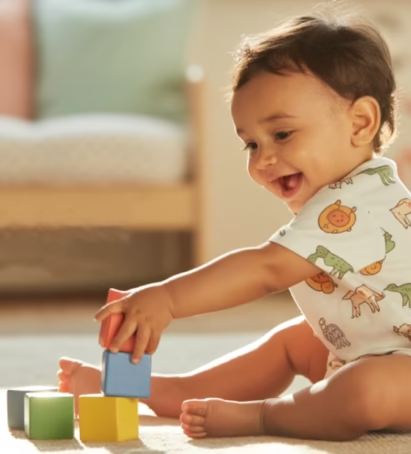The 7-Step Roadmap: Baby Clothes Manufacturing Process for Startups (From Sketch to Shipment)
Why the Manufacturing Process is Different for Baby Clothing
Conteúdo
For a baby clothing startup, the manufacturing process is about far more than just cost. You are creating products for the most vulnerable consumer group, meaning safety, quality, and compliance are the absolute highest priorities in design and production. A loose snap, an improper label, or a non-compliant fabric can lead to product recalls and legal issues.
[The Goal]
This roadmap is designed to help you launch a high-quality, safe product line efficiently and with minimal risk, avoiding costly production mistakes and laying a solid foundation for confident scaling.
[Key Startup Challenge]
The biggest hurdles for new brands are balancing Quantidades mínimas de encomenda (MOQs) and high upfront development costs. This guide offers strategies to navigate these challenges without sacrificing quality.
No idea how to make children’s clothes? This is the definitive, all-in-one guide the kids’ apparel industry doesn’t want you to have.
Pre-Production & Planning (The Blueprint)
Step 1: Design & Technical Flats
Your creative vision must be translated into engineering-level instructions the factory can understand.
-
Concept Sketches: Initial idea visualization and brand aesthetic.
-
Technical Sketches (Flats): Detailed black-and-white line drawings, often created using software like Adobe Illustrator. These show the garment’s front, back, side, and all specific details (pockets, seams, closures). This is the visual guide for pattern-making.
-
Pro Tip: If you lack design software skills, use existing garment templates or outsource this task to a professional Freelancer Pattern Maker/Technical Designer.
Step 2: The Tech Pack (Your Factory Contract)
The Tech Pack is your product’s instruction manual and the single most important document between you and your factory.
-
What it is: A comprehensive “how-to” guide containing every piece of information required to manufacture your garment.
-
Bill of Materials (BOM): Lists every component. Be highly specific, e.g., “GOTS-certified 100% Organic Cotton Jersey, 180 GSM,” “Nickel-free snaps, color Pantone 19-4008 TCX.”
-
Specification Sheet (Spec Sheet): Contains all critical measurements for each size. It defines the garment’s fit and illustrates grading—how measurements increase proportionally across the size range.

Com 17 anos de experiência, a petelulu oferece uma gama completa de
serviços de fabrico desde a conceção até à entrega.
Comece do zero, crie a sua própria marca.
17+
servindo as 10 principais marcas americanas
15+
servindo as 10 principais marcas australianas
12+
ao serviço das 10 principais marcas europeias
Contacte-nos para obter o orçamento.👇
Sourcing & Compliance (Safety First)
Step 3: Material Sourcing & Compliance Vetting
Fabric choices directly impact a child’s safety and skin health.
-
Baby-Safe Fabrics: Prioritize natural, breathable, and hypoallergenic materials such as Organic Cotton, Bamboo Viscose, and Merino Wool.
-
Certifications are Crucial: Understand the difference between key certifications:
-
GOTS (Global Organic Textile Standard): Ensures the entire supply chain, from raw material to finished product, is organic and environmentally sound.
-
OEKO-TEX Standard 100: Guarantees the fabric has been tested for and is free from harmful substances. This is the minimum safety requirement.
-
-
Vetting Manufacturers: You must ask for their experience with children’s wear, their ability to meet CPSIA standards (Consumer Product Safety Improvement Act), and proof of ethical labor practices.
Step 4: Sample Creation & Safety Testing
Sampling is the critical stage for verifying design and compliance.
-
Prototype/Fit Sample: The first physical sample created by the factory based on your Tech Pack. Focus here on fit, construction, and functionality (e.g., is the neck opening wide enough, does the zipper work smoothly?).
-
PPS (Pre-Production Sample): The final, approved sample that must be identical to the final bulk order. This is your sole benchmark for quality control.
-
Mandatory Testing: Lab testing for baby items is an unavoidable compliance cost:
-
Lead and Phthalates Content Testing.
-
Small Parts Testing (choking hazards).
-
Drawstring Testing (strangulation hazards).
-
Flammability Testing (especially for sleepwear).
-
Startup Note: These testing costs are significant and must be budgeted.
-

Production & Logistics (Scale)
Step 5: Bulk Production & Quality Control (QC)
This is where your design becomes a sellable product.
-
Cutting & Sewing: Explain how fabric is layered, cut precisely using patterns or computerized cutters, and then assembled by skilled sewers.
-
Low MOQ Strategy: For startups, attempt to negotiate low MOQs of 50–200 units per style/color. The trade-off you must accept is that lower MOQs mean higher per-unit costs.
-
Inline QC: Excellent manufacturers conduct quality checks durante the production process—not just at the end—to catch and fix errors early.
Step 6: Finishing, Branding, & Packaging
Details define the final brand experience.
-
Final Touches: Hemming, steaming, attachment of snaps/buttons, and thread trimming.
-
Custom Branding: Sewing in your custom woven/printed labels, attaching hangtags, and adding size stickers. Ensure all tracking labels comply with CPSIA requirements.
-
Final Inspection: Conduct a factory audit or hire a third-party inspector before the goods leave the factory to ensure the bulk order matches the approved PPS exactly and meets all safety/count requirements.
Step 7: Shipping, Logistics, & Fulfillment
Getting products to the customer requires an understanding of complex international trade terms.
-
Incoterms Primer:
-
FOB (Freight On Board): Cost and risk transfer to the buyer once the goods are loaded onto the vessel/plane.
-
Ex-Works (EXW): All costs and risks transfer to the buyer when the goods are ready at the factory door (highest risk for you).
-
-
Shipping Methods: Air freight (fast, expensive) vs. Ocean freight (slow, much cheaper for bulk). Startups often choose air freight initially for faster time-to-market.
-
Post-Production Costs: Be sure to factor in the hidden costs of duties, taxes, customs brokerage, and final warehousing/fulfillment fees.
V. Conclusion: Ready to Launch
A clear, detailed manufacturing roadmap is the best way for a new baby brand to manage risk and guarantee product quality. You now have the checklist covering everything from design to compliance.

Com 17 anos de experiência, a petelulu oferece uma gama completa de
serviços de fabrico desde a conceção até à entrega.
Comece do zero, crie a sua própria marca.
17+
servindo as 10 principais marcas americanas
15+
servindo as 10 principais marcas australianas
12+
ao serviço das 10 principais marcas europeias
Contacte-nos para obter o orçamento.👇
Perguntas frequentes (FAQ)
Q1: What is the average cost of a Tech Pack?
A: Hiring a professional garment technical designer for a complete Tech Pack averages between $150 and $500 per style. This is a crucial investment worth making.
Q2: How can I negotiate a lower MOQ without raising costs significantly?
A: Focus on a core collection (fewer styles and colors), use the factory’s existing color swatches (avoid custom dyeing), or choose low-MOQ manufacturers specializing in startups.
Q3: What should I budget for CPSIA lab testing?
A: Compliance testing costs vary by product complexity but typically range from $500 to $1,500 per style/batch. This is a mandatory, non-negotiable expense.
Sobre o autor
Xhiney, fundadora da Petelulu, tem mais de 20 anos de experiência em design, produção e comércio internacional de vestuário para crianças. Colaboradora da Roupa de criança e Júnior Xhiney passou 17 anos a trabalhar com marcas de roupa de criança de gama alta na Europa e nos EUA, oferecendo conhecimentos especializados e apoio.

